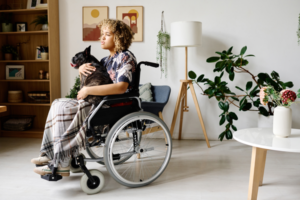 by Shalinie Dowlatram
by Shalinie Dowlatram
Gun violence leaves a variety of scars. Individuals who experience gun violence are often left with long-term adverse health outcomes such as chronic pain, depression, anxiety, and post-traumatic stress disorder (PTSD). PTSD1 is a mental health condition triggered by a terrifying event — either experiencing it or witnessing it – such as being exposed to gun violence. People who develop PTSD due to gun violence may experience flashbacks, may avoid triggers such as certain places that remind them of their traumatic experience, may startle easily, and may also experience adverse cognitive effects and negative mood symptoms such as disinterest in hobbies they once found enjoyable.2
Individuals can develop PTSD from the sudden unexpected loss of a loved one as well,3 even if they never faced a gun. PTSD burdens people who have suffered from gun violence with nightmares and symptoms that include difficulty concentrating due to stress and anger, difficulty learning new things, and memory loss.4 Gun violence reaches individuals untouched by bullets by taking their loved ones, fostering an unsafe environment, and creating lasting trauma for families and community members.
A 2020 research study assessed the health outcomes of patients who suffered from non-fatal firearm injuries 6 to 12 months after being injured and determined 53.2% of the patients screened positive for PTSD.5 This study also compared the physical and mental health outcomes of gunshot wound survivors to patients that sustained similar bodily injuries in motor vehicle crashes and determined people who suffered from gunshot wounds were three times more likely to develop PTSD and had increased odds of having chronic pain compared to patients injured in a motor vehicle crash.6
Firearm injuries burden individuals and their support systems to an unknown extent. PTSD can be a difficult mental health disorder to navigate without the help of a mental health professional and a strong support system. The long-term health outcomes of individuals that suffer from firearm-related injuries needs to be further studied to help assess the full scope of the problem.7
A study from 2017 hypothesized people who retain bullets in their body from firearm injuries are more likely to have more severe symptoms of PTSD compared to patients that suffered non-fatal firearm injuries with no retained bullets. The study concluded that retained bullets were associated with “more severe depressive symptoms in Black men” that suffered from firearm-related injuries.8 While literature supports the link between mental health issues and injuries, more research is needed to establish a relationship between severe PTSD symptoms and retained bullets. This study demonstrates patients’ need for psychological services and depression and PTSD screening after experiencing a firearm-related injury. People who suffered non-fatal firearm-related injuries may want to consider, with their healthcare provider’s guidance, removing retained bullets to improve their physical and mental health.9
Patients with comorbid chronic pain and PTSD may benefit from an integrated treatment plan (Kind & Otis, 2019). Evidence suggests PTSD and chronic pain may have a shared pathophysiology (Scioli-Salter et al., 2015). People who suffer from both chronic pain and PTSD have decreased levels of important neurosteroids (allopregnanolone and pregnanolone) and neuropeptides (Neuropeptide Y) responsible for helping the body regulate numerous physiological processes and regulate the antistress responses and regulate the part of the sensory nervous system responsible for controlling the body’s response to toxic stimuli (Scioli-Salter et al., 2015) (Antinociception). When people experience trauma or pain the concentration of neurosteroids and neuropeptides becomes dysregulated and this may explain the correlation between chronic pain and PTSD symptoms (Scioli-Salter et al., 2015). The physical pain associated with a firearm injury may arouse memories of trauma associated with getting hurt (Scioli-Salter et al., 2015). Chronic pain is a catalyst for PTSD for gun violence survivors.
More research is needed to understand how PTSD interacts with trauma and pain and how PTSD impacts the lives of people who experience gun violence. The long-term health outcomes of those who suffer from gun violence is vastly under studied. Studying how PTSD reduces the quality of life for those who have experienced gun violence may lead to evidence-based interventions for improving long-term mental health outcomes.
References
1 Post-traumatic stress disorder (PTSD)
2 U.S. Department of Health and Human Services. (n.d.). Post-traumatic stress disorder. National Institute of Mental Health. Retrieved November 21, 2022, from https://www.nimh.nih.gov/health/topics/post-traumatic-stress-disorder-ptsd
3 ibid
4 How PTSD impairs learning and memory. Columbia University Irving Medical Center. (2012, August 30). Retrieved November 25, 2022, from https://www.cuimc.columbia.edu/news/how-ptsd-impairs-learning-and-memory#:~:text=But%20one%20of%20the%20most,ability%20to%20learn%20new%20things.
5 Herrera-Escobar, J. P., de Jager, E., McCarty, J. C., Lipsitz, S., Haider, A. H., Salim, A., & Nehra, D. (2020). Patient-reported outcomes at 6 to 12 months among survivors of firearm injury in the United States. Annals of Surgery, 274(6). https://doi.org/10.1097/sla.0000000000003797
6 ibid
7 ibid
8 Smith, R. N., Seamon, M. J., Kumar, V., Robinson, A., Shults, J., Reilly, P. M., & Richmond, T. S. (2018). Lasting impression of violence: Retained bullets and depressive symptoms. Injury, 49(1), 135–140. https://doi.org/10.1016/j.injury.2017.08.057
9 Ibid
Kind, S., & Otis, J. D. (2019, November 28). The interaction between chronic pain and PTSD – current pain and headache reports. SpringerLink. Retrieved December 1, 2022, from https://link.springer.com/article/10.1007/s11916-019-0828-3
Scioli-Salter, E. R., Forman, D. E., Otis, J. D., Gregor, K., Valovski, I., & Rasmusson, A. M. (2015). The shared neuroanatomy and neurobiology of comorbid chronic pain and PTSD. The Clinical Journal of Pain, 31(4), 363–374. https://doi.org/10.1097/ajp.0000000000000115
Antinociception. Antinociception – an overview | ScienceDirect Topics. (n.d.). Retrieved December 1, 2022, from https://www.sciencedirect.com/topics/pharmacology-toxicology-and-pharmaceutical-
science/antinociception#:~:text=Antinociceptive%20Activity,by%20the%20sensory%20nervous%20system.
